Never miss another geomagnetic storm. Sign up for Space Weather Alerts and you'll receive a text message when magnetic storms erupt. Aurora tour guides and professional astronomers use this service. You can, too! | | |
THE WORLD'S LARGEST SOLAR TELESCOPE: The US National Science Foundation has just released astonishing new images of the sun to celebrate the inauguration of the Daniel K. Inouye Solar Telescope on Maui, Hawai’i. With a four-meter diameter mirror, it is currently the largest solar telescope in the world able to resolve features on the sun as small as 18 km. Take a look.
A SUNSPOT WITH A TAIL: Sunspot AR3092 has a tail--a really long one. "It extends for about 390,000 km above the surface of the sun," says Eduardo Schaberger Poupeau who photographed the structure from Rafaela, Argentina:
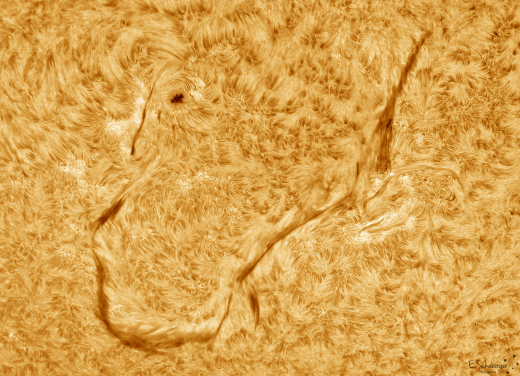
"To understand this size more visually, the dark core of sunspot AR3092, seen in the upper left, is about the size of planet Earth," notes Poupeau.
The sunspot's tail is a filament of magnetism emerging from the sunspot's core and curling away into the sun's atmosphere. Contained inside the filament is a long tube of relatively cool, dark pasma. Only one end of the filament is moored, so it could become unstable and begin to move around. A flick of this tail could send a CME toward Earth. Stay tuned.
more images: from Alan Friedman of Buffalo, NY; from Howard Eskildsen of Ocala, Florida; from Rossana Miani of Padova, Italy;
Realtime Space Weather Photo Gallery
Free: Spaceweather.com Newsletter
MAJOR FARSIDE CME AND RADIATION STORM (UPDATED): Something just exploded on the farside of the sun. NASA's STEREO-A spacecraft recorded a magnificent full-halo CME emerging during the late hours of Sept. 5th:
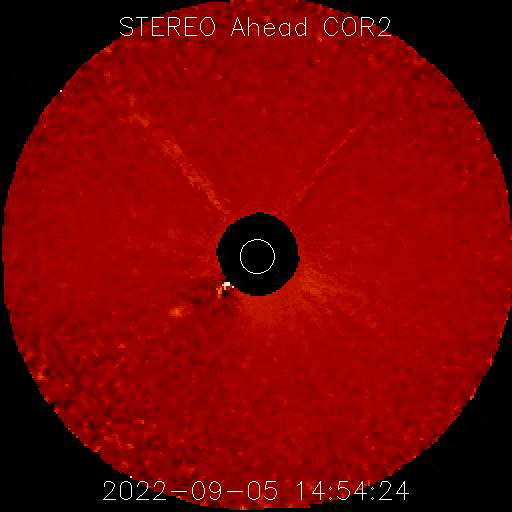
A NASA model of the CME shows it heading away from Earth and directly toward Venus. This will be the second time in a week that Venus has been hammered by a significant solar storm. An earlier CME struck on Sept. 1st, probably launched by the same farside sunspot.
"This is no run of the mill event," says George Ho of the Johns Hopkins Applied Physics Lab. "Many science papers will be studying this for years to come."
Ho is the principal investigator for an energetic particle detector onboard Europe's Solar Orbiter spacecraft--and he is getting a lot of data right now. Solar Orbiter just performed a close flyby of Venus (only 6420 km away) to adjust its orbit around the sun. It is in the perfect position to observe the storm.
This plot shows a wave of energetic particles washing over the spacecraft:
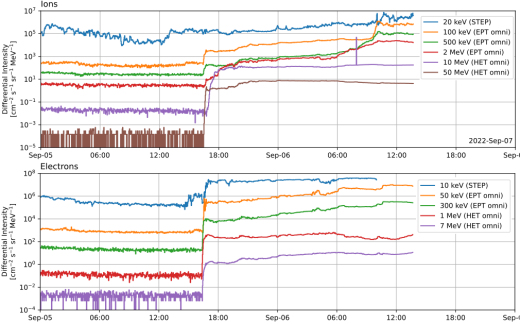
Above: Data from Solar Orbiter's EPD/Suprathermal Ion Spectrograph. These are quick-look data; they have not been checked for accuracy and are subject to revision
"I can safely say the Sept. 5th event is one of the largest (if not THE largest) Solar Energetic Particle (SEP) storms that we have seen so far since Solar Orbiter launched in 2020," says Ho. "It is at least an order of magnitude stronger than the radiation storm from last week's CME."
"In fact, the >10 MeV and >50 MeV particle intensity has not subsided since the beginning of the storm yesterday," adds Ho. "This is indicative of a very fast and powerful interplanetary shock, and the inner heliosphere may be filled with these high-energy particles for a long time. I think I've only seen couple of these in the last couple solar cycles."
Earth is not affected by the storm, which is happening on the opposite side of the sun. However, we may not be safe from its source. The underlying explosion almost certainly happened in the magnetic canopy of AR3088, an active sunspot that popped up on the Earthside of the sun in August. It is now transiting the farside, apparently bigger and angrier than before. The sun's rotation will turn AR3088 toward us again in little more than a week, putting Earth back in the line of fire. Stay tuned.Solar flare alerts: SMS Text
Realtime Aurora Photo Gallery
Free: Spaceweather.com Newsletter
"I LOVE YOU FOREVER" PENGUIN PENDANT: Does someone in your life love penguins? This may be the perfect gift. On Aug. 26, 2022, the students of Earth to Sky Calculus launched a sterling silver penguin pendant onboard a cosmic ray research balloon. The loving pair flew 107,400 feet high, above 99.5% of Earth's atmosphere:
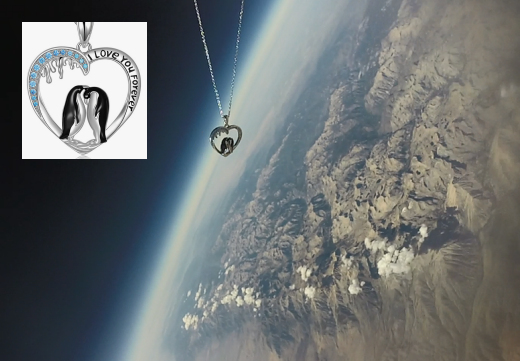
You can have it for $133.95. The two penguins are framed by a sterling silver heart inscribed with the words "I Love You Forever." It comes with a matching hypoallergenic 18-inch chain. Also included is a greeting card showing the pendant in flight and telling the story of its trip to the edge of space.
Far Out Gifts: Earth to Sky Store
All sales support hands-on STEM education
Realtime Noctilucent Cloud Photo Gallery
Free: Spaceweather.com Newsletter
Every night, a network of
NASA all-sky cameras scans the skies above the United States for meteoritic fireballs. Automated software maintained by NASA's Meteoroid Environment Office calculates their orbits, velocity, penetration depth in Earth's atmosphere and many other characteristics. Daily results are presented here on Spaceweather.com.
On Sep 06, 2022, the network reported 10 fireballs.
(9 sporadics, 1 Sept. epsilon Perseid)
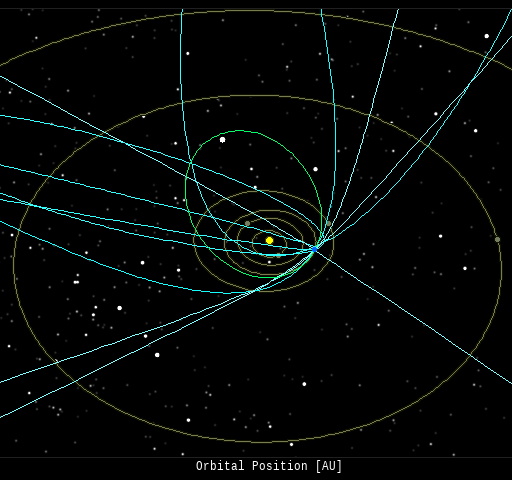
In this diagram of the inner solar system, all of the fireball orbits intersect at a single point--Earth. The orbits are color-coded by velocity, from slow (red) to fast (blue). [Larger image] [movies]
Potentially Hazardous Asteroids (
PHAs) are space rocks larger than approximately 100m that can come closer to Earth than 0.05 AU. None of the known PHAs is on a collision course with our planet, although astronomers are finding
new ones all the time.
On September 7, 2022 there were 2292 potentially hazardous asteroids.
 |
Recent & Upcoming Earth-asteroid encounters: | Asteroid | Date(UT) | Miss Distance | Velocity (km/s) | Diameter (m) |
| 2022 RV2 | 2022-Sep-02 | 1.8 LD | 15 | 26 |
| 2022 RS1 | 2022-Sep-02 | 1.3 LD | 3.8 | 10 |
| 2022 RQ1 | 2022-Sep-02 | 1.6 LD | 10.6 | 12 |
| 2022 QN5 | 2022-Sep-02 | 2.4 LD | 13.5 | 25 |
| 2022 RD2 | 2022-Sep-03 | 8.4 LD | 0.8 | 6 |
| 2022 QO31 | 2022-Sep-03 | 13.9 LD | 8.4 | 50 |
| 2022 RB2 | 2022-Sep-03 | 0.7 LD | 13 | 11 |
| 2022 RK | 2022-Sep-04 | 9.4 LD | 7.8 | 22 |
| 2022 QJ7 | 2022-Sep-05 | 14.8 LD | 12 | 26 |
| 2022 QU5 | 2022-Sep-05 | 19.2 LD | 7.1 | 31 |
| 2022 RW | 2022-Sep-05 | 2.9 LD | 11.2 | 75 |
| 2022 QC7 | 2022-Sep-06 | 12.2 LD | 9.1 | 22 |
| 2022 QR31 | 2022-Sep-06 | 19.9 LD | 11.3 | 54 |
| 2022 RR1 | 2022-Sep-07 | 1.9 LD | 8.2 | 17 |
| 2022 QB22 | 2022-Sep-09 | 14.2 LD | 17.5 | 58 |
| 2022 QF2 | 2022-Sep-11 | 19.1 LD | 8.4 | 44 |
| 2022 RE | 2022-Sep-11 | 6 LD | 12.3 | 22 |
| 2022 RJ2 | 2022-Sep-12 | 3 LD | 15.9 | 14 |
| 2008 RW | 2022-Sep-12 | 17.5 LD | 10.2 | 98 |
| 2022 RQ | 2022-Sep-13 | 9.8 LD | 13.8 | 26 |
| 2022 RJ1 | 2022-Sep-15 | 19.7 LD | 3.3 | 19 |
| 2020 PT4 | 2022-Sep-15 | 18.8 LD | 10.8 | 39 |
| 2022 QD1 | 2022-Sep-16 | 19.5 LD | 9.5 | 74 |
| 2005 RX3 | 2022-Sep-18 | 12.4 LD | 17.5 | 123 |
| 2022 QB37 | 2022-Sep-18 | 17.2 LD | 9.2 | 56 |
| 2022 QJ50 | 2022-Sep-19 | 11 LD | 10.2 | 34 |
| 2022 QH8 | 2022-Sep-22 | 10.6 LD | 15.3 | 54 |
| 2022 QK36 | 2022-Sep-23 | 18.7 LD | 3.7 | 22 |
| 2022 RM | 2022-Sep-25 | 14.2 LD | 10 | 32 |
| 2016 HF2 | 2022-Sep-29 | 19.2 LD | 5.6 | 21 |
| 2018 ER1 | 2022-Oct-02 | 14.7 LD | 4 | 27 |
| 2018 VG | 2022-Oct-05 | 18.5 LD | 6.7 | 12 |
| 2021 TJ10 | 2022-Oct-06 | 19.6 LD | 8.1 | 6 |
| 2006 SG7 | 2022-Oct-07 | 16.7 LD | 18.4 | 93 |
| 2013 TJ6 | 2022-Oct-07 | 11.7 LD | 14.4 | 32 |
| 2013 SL20 | 2022-Oct-14 | 6.2 LD | 12.1 | 45 |
| 2020 TO2 | 2022-Oct-15 | 1.4 LD | 12.6 | 18 |
| 2020 BD | 2022-Oct-16 | 12.1 LD | 11.4 | 20 |
| 2022 QM6 | 2022-Oct-17 | 19.8 LD | 4.2 | 69 |
| 2016 TH94 | 2022-Oct-25 | 19.1 LD | 13.5 | 43 |
| 2019 AN5 | 2022-Oct-27 | 20 LD | 6.8 | 213 |
| 2004 UT1 | 2022-Oct-29 | 4 LD | 6.3 | 17 |
| 2021 VH | 2022-Nov-01 | 5.9 LD | 5.3 | 4 |
Notes: LD means "Lunar Distance." 1 LD = 384,401 km, the distance between Earth and the Moon. 1 LD also equals 0.00256 AU. | | Cosmic Rays in the Atmosphere |
SPACE WEATHER BALLOON DATA: Almost once a week, Spaceweather.com and the students of Earth to Sky Calculus fly space weather balloons to the stratosphere over California. These balloons are equipped with sensors that detect secondary cosmic rays, a form of radiation from space that can penetrate all the way down to Earth's surface. Our monitoring program has been underway without interruption for 7 years, resulting in a unique dataset of in situ atmospheric measurements.
Latest results (July 2022): Atmospheric radiation is decreasing in 2022. Our latest measurements in July 2022 registered a 6-year low:
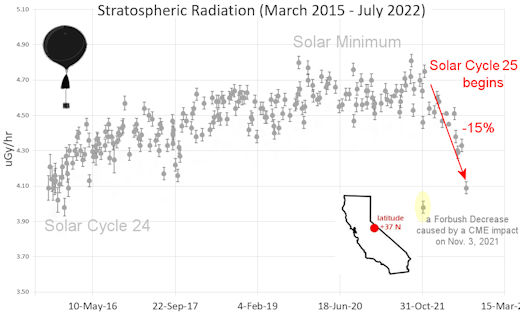
What's going on? Ironically, the radiation drop is caused by increasing solar activity. Solar Cycle 25 has roared to life faster than forecasters expected. The sun's strengthening and increasingly tangled magnetic field repels cosmic rays from deep space. In addition, solar coronal mass ejections (CMEs) sweep aside cosmic rays, causing sharp reductions called "Forbush Decreases." The two effects blend together to bring daily radiation levels down.
.Who cares? Cosmic rays are a surprisingly "down to Earth" form of space weather. They can alter the chemistry of the atmosphere, trigger lightning, and penetrate commercial airplanes. According to a study from the Harvard T.H. Chan school of public health, crews of aircraft have higher rates of cancer than the general population. The researchers listed cosmic rays, irregular sleep habits, and chemical contaminants as leading risk factors. A number of controversial studies (#1, #2, #3, #4) go even further, linking cosmic rays with cardiac arrhythmias and sudden cardiac death.
Technical notes: The radiation sensors onboard our helium balloons detect X-rays and gamma-rays in the energy range 10 keV to 20 MeV. These energies span the range of medical X-ray machines and airport security scanners.
Data points in the graph labeled "Stratospheric Radiation" correspond to the peak of the Regener-Pfotzer maximum, which lies about 67,000 feet above central California. When cosmic rays crash into Earth's atmosphere, they produce a spray of secondary particles that is most intense at the entrance to the stratosphere. Physicists Eric Regener and Georg Pfotzer discovered the maximum using balloons in the 1930s and it is what we are measuring today.
| | The official U.S. government space weather bureau |
| | The first place to look for information about sundogs, pillars, rainbows and related phenomena. |
| | Researchers call it a "Hubble for the sun." SDO is the most advanced solar observatory ever. |
| | 3D views of the sun from NASA's Solar and Terrestrial Relations Observatory |
| | Realtime and archival images of the Sun from SOHO. |
| | information about sunspots based on the latest NOAA/USAF Active Region Summary |
| | current counts of failed and deployed Starlink satellites from Jonathan's Space Page |
| | Authoritative predictions of space junk and satellite re-entries |
| | from the NOAA Space Environment Center |
| | fun to read, but should be taken with a grain of salt! Forecasts looking ahead more than a few days are often wrong. |
| | from the NOAA Space Environment Center |
| | the underlying science of space weather |
 | BestCSGOGambling is the best site for everything related to CSGO gambling on the web |
 | To find reviews of new online casino sites in the UK try The Casino DB where there are hundreds of online casino reviews complete with bonuses and ratings. Alternatively, Online-Casinos.xyz is another massive directory of online casinos listing sites for the UK and Worldwide. Casinos that offer Rupees for bonuses are very generous to Indian players. Find the best online casinos in India at AllCasinos.in Looking for a new online casino? Try Casimpo the new site dedicated to making online casino simple, or check out the new Avenger Slots Casino and Ace Online Casino with over 500 online slots and casino games. |
 | One of the most popular casino games is the Book Of Dead Slot based on ancient Egyptian text, you can find all the casinos with spins at bookofdeadslotsites.com. |
 | When looking for casinos to play online when the weather is bad, you can try casino online trucchi for Italian games. If you are not from Finland you can try the Swedish page Svenska casino online to find suitable games, check out svenskacasinoonline.net. Always check your local laws before playing with real money. |
 | Looking for sports betting companies not registered on GamStop? CasinoGap has presented a list of sites not on GamStop available for UK players. Check and bet online! Would you like to bet at sites not using GamStop? Look at a list of NonStopCasino sites for online betting that aren't on GamStop. Top-rated bookmakers ever! |
| | These links help Spaceweather.com stay online. Thank you to our supporters! |
| | | | | | |

